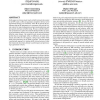Free Online Productivity Tools
i2Speak
i2Symbol
i2OCR
iTex2Img
iWeb2Print
iWeb2Shot
i2Type
iPdf2Split
iPdf2Merge
i2Bopomofo
i2Arabic
i2Style
i2Image
i2PDF
iLatex2Rtf
Sci2ools
SIGMETRICS
2008
ACM
2008
ACM
An SLA perspective on the router buffer sizing problem
In this paper, we discuss recent work on buffer sizing in the context of an ISP's need to offer and guarantee competitive Service Level Agreements (SLAs) to its customers. Since SLAs specify the performance that an ISP guarantees to its customers, they provide critical context for many configuration and provisioning decisions and have specific relevance to buffer sizing. We use a controlled laboratory environment to explore the tradeoffs between buffer size and a set of performance metrics over a range of traffic mixtures for three different router designs. Our empirical study reveals performance profiles that are surprisingly robust to differences in router architecture and traffic mix and suggests a design space within which buffer sizing decisions can be made in practice. We then present a preliminary approach for making buffer sizing decisions within this framework that relates directly to performance and provisioning requirements in SLAs.
Hardware | Performance | SIGMETRICS 2008 | Sizing | SLAs |
| Added | 15 Dec 2010 |
| Updated | 15 Dec 2010 |
| Type | Journal |
| Year | 2008 |
| Where | SIGMETRICS |
| Authors | Joel Sommers, Paul Barford, Albert G. Greenberg, Walter Willinger |
Comments (0)

